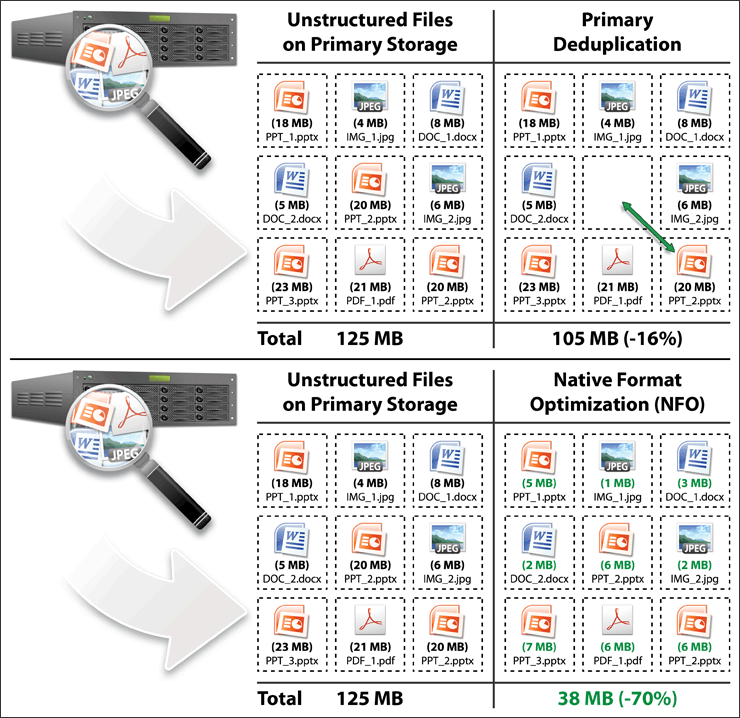balesio Native Format Optimization Technology (NFO)
balesio's native data reduction appliances and software solutions provide storage capacity optimization through NFO technology.
Our solutions optimize unstructured data on primary storage by 50-90% and help enterprises to optimize existing storage capacities as well as to flatten rapid data storage growth without impacting storage and network performance. On the contrary, the native data optimization increases the performance of data throughput and network operations. Easy to install and use, our solutions support any type of storage and no infrastructure changes are necessary.
Our NFO technology is composed of a comprehensive set of content-aware native optimization algorithms especially developed for unstructured file formats such as Microsoft Office files, PowerPoint presentations, PDF files and images. Our technology reduces the footprint of these files by up to 50 times while preserving the original file format, making a subsequent rehydration or decompression unnecessary.
Table of Contents
White Paper
balesio's native format optimization technology provides enterprises the following benefits:
- Native data reduction of unstructured files by 50-90%
- Performance increase due to smaller file sizes
- Visually lossless data reduction
- Significant data reduction on unstructured files (represent 70-80% of total primary storage)
- Fully transparent
- Agnostic to applications, networks, storage
- No file rehydration necessary
- Complementary to any other storage efficiency technology (deduplication, archiving, etc.)
- High availability
- Data is always available and at any time
- Deploys seamlessly into high-availability environments
Our Technology: Native Format Optimization Technology
Our NFO technology is uniquely positioned and a truly innovative approach to significant primary data reduction. It is distinctively different from deduplication as all of our optimization mechanisms take place within a single file and not across files.
As well, it is distinctively different from compression technologies. All of our optimization mechanisms preserve the original file format. Space reduction is achieved by finding and reducing redundancies and inefficiencies internally within the given file container. As such, the original file format is unaltered and no decompression or rehydration is necessary. Also, resulting files are and remain fully compliant as every optimization takes place within the given standard of each supported file format.
| Example Files | ||||
| * using "Visually Lossless Display" compression setting | ||||
| Original File | FILEminimizer Optimized File | Compression * | ||
|---|---|---|---|---|
| 0% | ||||
| 92% | ||||
| 91% | ||||
| 83% | ||||
| 85% | ||||
Native Format Optimization Technology vs. Compression

NFO technology is designed for unstructured files with a mixture of content elements (e.g. images, graphics, elements, objects, text, etc.) and is therefore far more effective on unstructured files than traditional compression methods, such as ZIP compression. Natively optimizing a large Microsoft PowerPoint presentation will often reduce its file size by 50-90% while zipping the same presentation will result in a low compression rate of below 10% as included elements are already compressed. And, as natively optimized files remain in their original format, there's no need to unzip an optimized file before using it.
Native Format Optimization Technology vs. Primary Deduplication

NFO technology is designed for unstructured files which usually represent between 70-80% of the total data volume on primary storage. NFO offers content-aware optimization methods which work on an intra-file level, i.e. within a given file container. On unstructured files, this technology provides higher data reduction ratios than primary deduplication for the fact that redundancies across files are less frequent on primary storage. Therefore, the effect of primary deduplication on unstructured files is limited. NFO on the other hand finds the optimization potential within each single file and reduces primary storage data volume of unstructured files by 50-85%.
How Native Format Optimization Technology Works
balesio's native format optimization technology applies a comprehensive set of content-aware optimization mechanisms which are both "lossless" and "visually lossless" meaning they are technically "lossy", but in practice deliver optimized files which are visually identical to the original. balesio's development team has carefully developed enhanced image coding algorithms that align precisely with the sensitivities of the human visual system to deliver visually lossless results to the user. In addition, balesio engineers have developed a set of content-aware optimization technologies especially designed for main unstructured file formats such as PowerPoint, Word, Excel and PDF. Techniques employed to reduce single file sizes via NFO include intra-file object deduplication, object format optimization, object slimming, noise reduction, quantization adjustment, optimization of non-visual data, enhanced image encoding and other methods.
By intelligently reducing single file sizes and leaving them in their optimized state through the whole information lifecycle, customers using our NFO technology are realizing benefits in bandwidth cost and improved end-user experience, in addition to reducing storage costs and backup data volume.
While with standard compression or deduplication workflow the read-back of files requires rehydration, the NFO workflow is entirely different: files are optimized but stored in their native file format (for example the image file "IMG_1.jpg" is natively optimized and stored as "IMG_1.jpg") - a read-back of an optimized file requires no rehydration.
